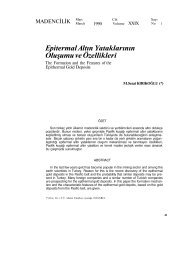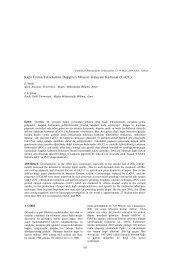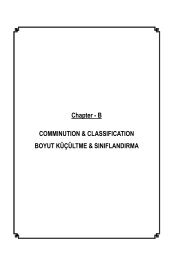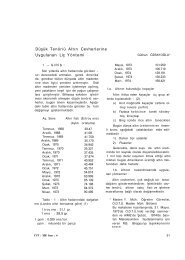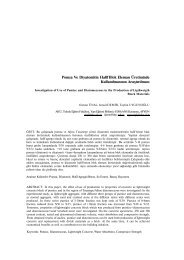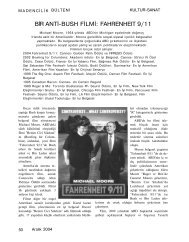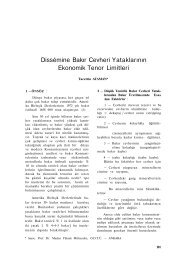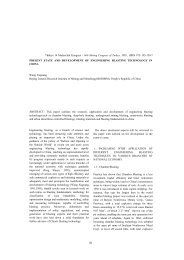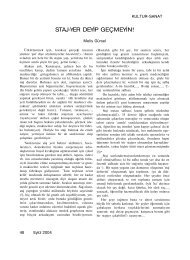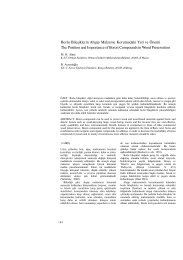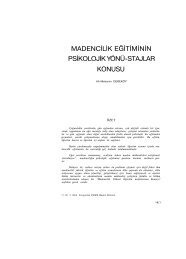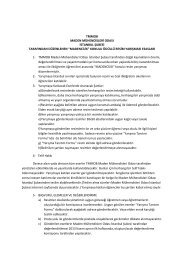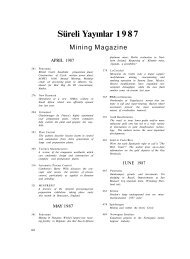A OPEN PIT MINING AÇIK OCAK MADENCİLİĞİ
A OPEN PIT MINING AÇIK OCAK MADENCİLİĞİ
A OPEN PIT MINING AÇIK OCAK MADENCİLİĞİ
You also want an ePaper? Increase the reach of your titles
YUMPU automatically turns print PDFs into web optimized ePapers that Google loves.
product that must be produced from the<br />
mine.<br />
MaximizeT<br />
X<br />
bx<br />
b<br />
(2)<br />
bB<br />
Subject to:<br />
gb<br />
Gmin x<br />
b<br />
0<br />
(3)<br />
bB<br />
<br />
<br />
i i<br />
imb<br />
immax x<br />
b<br />
0, i 1,...,<br />
nim<br />
(4)<br />
bB<br />
<br />
<br />
x<br />
b<br />
0,1 , b B<br />
(5)<br />
In this model, T is the total tonnage of<br />
final blended material to be maximized, b is<br />
the block identifier, and B is the set of<br />
potential ore blocks in the block model. X<br />
b<br />
is the tonnage of material in block b, and x<br />
b<br />
is the decision variable. If x<br />
b<br />
is equal to 1,<br />
then block b is included in the blended<br />
product, and if x<br />
b<br />
is equal to 0, then block b<br />
is not included in the blended product and it<br />
will be treated as a waste block. g<br />
b<br />
and G<br />
min<br />
are the grade of material in block b, and<br />
minimum allowable grade of final blended<br />
i<br />
i<br />
product respectively. n<br />
im<br />
, im<br />
b<br />
, and im<br />
max<br />
are<br />
the number of impurities in the ore deposit,<br />
grade of impurity i in block b, and maximum<br />
allowable amount of impurity i, in the final<br />
blended product respectively.<br />
The aim of the model is to maximize the<br />
total tonnage of the blended product<br />
(Equation 2). Equation 3 guaranties that the<br />
grade of the final product is greater than the<br />
minimum required. Equations 4, is used to<br />
make sure that the amount of impurities<br />
(contaminants) in the final product is lower<br />
than the maximum allowed. Equation 5,<br />
make sure that the decision variables are<br />
binary.<br />
The model presented in equations 2-5,<br />
selects a sub set of potential ore blocks that<br />
meets the blending requirements, and it does<br />
not consider the final outline of the mine (pit<br />
limit). The set of the selected potential ore<br />
blocks is the input of the pit optimization<br />
algorithms. The values of the potential ore<br />
blocks are assigned to be equal to the value<br />
of the final product, and those ore blocks that<br />
are not selected for blending are treated as<br />
waste blocks. Then it is possible to determine<br />
BEVs and the ultimate pit limit. In the next<br />
section the approach to combine pit and<br />
blend optimization is presented.<br />
4 <strong>PIT</strong> AND BLEND OPTIMIZATION<br />
There are a number of pit design algorithms<br />
which is discussed in section 2. These<br />
algorithms require that the BEV of each<br />
block to be determined prior to applying the<br />
algorithms. In order to determine the BEV of<br />
the blocks, one needs to first select the set of<br />
blocks that can be blended. Then the BEV of<br />
these blocks is set to be equal to the value of<br />
final product. After this, one could apply any<br />
available methods to determine the ultimate<br />
pit limit (UPL). Figure 1 presents the<br />
procedure of determining the ultimate pit and<br />
blend limit according to Osanloo and<br />
Rahmanpour (2012).<br />
Figure 1. The procedure of determining the<br />
ultimate pit-blend limit<br />
According to figure 1 the steps of<br />
determining the ultimate pit-blend limit is as<br />
follow.<br />
Step 1) The potential ore blocks are<br />
selected from the block model based on<br />
characteristics such as rock type and ore<br />
grade. The set of these blocks are named S.<br />
Step 2) Set S is fed into the blend<br />
optimizing model to identify and select those<br />
block which satisfy the blending<br />
requirements. The set of those blocks that<br />
meet the blending requirements are called<br />
122



